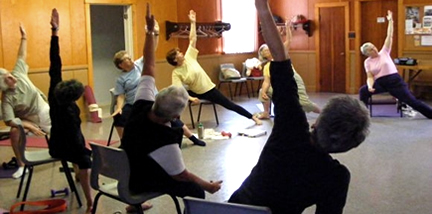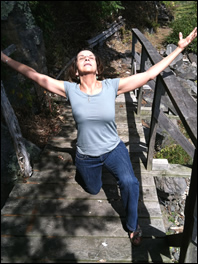
A woman I know was clearly annoyed observing a Chair Yoga class at her gym when she told me “those people need to get up and move.” Her comment made me wonder about the misconceptions people may have about a Chair Yoga class.
Participants in the Chair Yoga for Seniors class I teach range in age from late 60s to early 90s. While they can stand for some poses, some using the chair for stability, they are not getting down on the floor. But they want the benefits of improved stability, flexibility and balance in their bodies, self-awareness and clarity in their minds, and a sense of calm and balance at the level of emotions. They want to worry less and enjoy their lives more.
An understanding of yoga postures or asana can be helpful in understanding the value of what can be done in a Chair Yoga class. Yoga postures are divided into categories based upon their functions. For example, the function of bending forward in a posture is to stretch the back. The function of a back-arching pose is to stretch the front of the body; a twist twists the spine; a lateral pose stretches the sides of the body. As we work in postures in Chair Yoga, we need to achieve the function of the classical postures in a modified context.
Let’s keep this in mind: if someone 70 years old has a stiff back and legs, gently bending forward while seated will stretch the back. The function of the pose can be achieved even though the form differs from the classic form of bending forward standing, legs straight, hands on the floor. In fact, trying to achieve this form could cause injury to the person with such stiffness.
When people assume that someone should move a certain way to be doing yoga, they are missing the point. When a person using the breath in a way that supports that function and moves prana or energy. By connecting the mind and body through movement, the mind begins to focus. Awareness develops as the participants are given time to observe the effects of what they have done. Additional work is done as they sit with an assigned breathing practice to steady breath and mind.
The point I want to make is, depending upon the audience, a Chair Yoga can offer the benefits of regular yoga class. In form it may not look as demanding as the posture done classically, but it might be accomplishing the same benefit based upon condition of the person doing the posture. We have to remember that we are all different. There is no one yoga practice to fit all people at every age. But there is a yoga for everyone and every body.
Chair Yoga is a gentle, non-traditional form of Yoga that reduces strain on limbs and joints. Participants are guided in postures, breathwork, and meditation. Postures may be done in the chair and/or standing with the support of the chair. This practice promotes stability and flexibility at the level of the body, self-awareness and clarity at the level of the mind, a sense of calm and balance at the level of the emotions, and overall wellness
Chair Yoga at Susquehanna Township Recreation Building meets Thursdays from 11:00 am to noon. Please contact me at eterryyoga@gmail.com or call 717-645-0067 for more information or to sign-up.


 Today at my family’s Labor Day picnic, my niece, an avid gardener, showed me a tomato-devouring hornworm. Bright green, about three inches long, and fat from having feasted on my brother-in-laws tomato plant. He was big enough to see even the detail of his mouth and the aphids that had taken up residence as parasites. I loved seeing him in all his brilliant green detail even while hoping my tomatoes would escape his attentions.
Today at my family’s Labor Day picnic, my niece, an avid gardener, showed me a tomato-devouring hornworm. Bright green, about three inches long, and fat from having feasted on my brother-in-laws tomato plant. He was big enough to see even the detail of his mouth and the aphids that had taken up residence as parasites. I loved seeing him in all his brilliant green detail even while hoping my tomatoes would escape his attentions.  No, I am not a thief, but…
No, I am not a thief, but… “You have to say ‘no’ to what you don’t want in order to be able to say ‘yes’ to what you do want.” My yoga teacher, Fran Ubertini, told me this almost every time we met in our private sessions. It took me a long time to grasp what she really meant and apply it in my life.
“You have to say ‘no’ to what you don’t want in order to be able to say ‘yes’ to what you do want.” My yoga teacher, Fran Ubertini, told me this almost every time we met in our private sessions. It took me a long time to grasp what she really meant and apply it in my life.